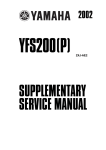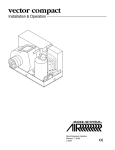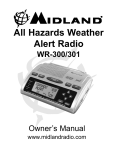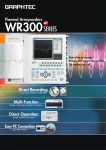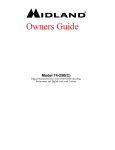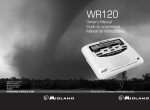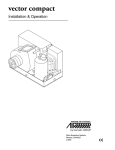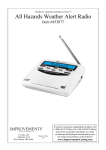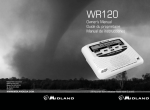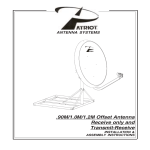Download Midland WR-300 Owner`s manual
Transcript
Midland Radio WR‐300 Desktop All Hazards NOAA Weather Radio FIELD EVALUATION DATE: October 19, 2011 PRODUCT: WR‐300 SAME All Hazards NOAA Weather Radio LOCATION: Northeast Ohio / Central Virginia EVALUATORS: Mr. Andrew Boggs & ICE PACK Emergency Preparedness Staff OBJECTIVE/PURPOSE: Field Test the Midland Radio WR300 Desktop All Hazards NOAA Weather Radio for use as a crisis communications radio during extreme weather emergencies and disasters. PRODUCT OVERVIEW As of August 2011, there were 1,665 tornadoes across the country resulting in 549 fatalities. There have been 14 named storms from the National Hurricane Center this year so far and predicted storms for the remainder of the year have increased to 19. Hurricane Irene alone caused 46 fatalities across 13 states. Hurricane season officially starts on June 1st and ends on November 30th, but, like tornadoes, hurricanes can form anytime of the year. With a hurricane there is at least an advanced warning of a few days, whereas tornado warnings average only ten minutes notice. Just this week, tornadoes touched down here in Central and Northern Virginia. These events come on the heels of our region’s first 5.8 magnitude earthquake since the 1800's which continues to produce after-shocks – the latest being just last night. Having adequate warning of an impending hurricane, tornado, severe snow storm, and flooding is crucial if we are to mitigate such events in our lives or in the lives of those for whom we are responsible. Therefore an all hazards weather radio equipped with S.A.M.E. technology is a good investment. The Midland WR-300 All Hazards Weather Radio makes a lot of sense in keeping you, your family, and workplace informed. While broadcast radio and television do an excellent job of keeping you aware of severe weather activities, such resources are crippled during a power outage and are limited when we are involved in many of our daily activities – sleeping, working, enjoying leisure activities – Page 1 P.O. BOX 8024 CHARLOTTESVILLE, VIRGINIA USA 22906 • TEL 434.244.7140 • FAX 434.296.9260 www.ICE-PACK.com • E-mail: [email protected] when such devices are often not accessible or simply powered off. Oftentimes people can be caught unaware to the point where it becomes too late to react. Weather radios have been on the market for decades, but unless they utilize S.A.M.E technology, they spend most of their time switched off, offering very little use if storms suddenly brew or disasters strike. S.A.M.E. stands for Specific Area Message Encoding which decodes a 1050 Hz tone for a ten second burst from the National Weather Service. The weather radio receiver itself usually reacts within five seconds. Digital information within the initial transmission decoded on radios equipped with S.A.M.E. circuitry trigger digital readouts which describe the alert such as ‘tornado’ or ‘hurricane’ on the weather radio display. Beyond weather, S.A.M.E. radios are equipped with other hazardous information, including AMBER alerts. Some radios just light up a single LED bulb alerting you to tune in to hear details of the alert. Midland Radio Corporation was established in the 1960’s with its parent company, CTI, located in Italy. Many of its radios, however, are actually made in China – including the WR-300. Midland specializes in Citizen Band radios, 2-way radios and other similar equipment. Midland is also involved in the manufacture of S.A.M.E -equipped weather or all-hazard radio receivers which meet specific needs. The Midland WR-300 radio equipped with S.A.M.E. circuitry is one of those radios you might want to have at bedside, by your desk, or at a central location in your workplace. The WR-300 is a clock radio as well a weather radio. However it’s a bit more complicated than the alarm radio you may use at home. For instance, the snooze control is all the way on the left side of the radio, rather than the large button in the middle which is relegated to the weather/hazard on-off switch. Keep in mind, “intuitive” can have different meanings to different people. Other buttons above the display include snooze on the far left, alert on-off, weather/hazard on-off switch, AM-FM selection and radio button on the far right. On the left of the display you will find LED indicator lights for warning, watch and advisory to indicate the condition being reported. Page 2 P.O. BOX 8024 CHARLOTTESVILLE, VIRGINIA USA 22906 • TEL 434.244.7140 • FAX 434.296.9260 www.ICE-PACK.com • E-mail: [email protected] The blue backlit readout panel indicates the specific hazard, time, type of transmission and channel from which the information is originating. The unit is also capable of displaying full calendar information, including month, day and year. Speaking of time, unlike some weather radios in the past, the WR-300 will not set the time like an “atomic” WWV clock radio will. You’ll have to reset it for daylight savings time changes. This is perhaps one of the radio’s very minor shortcomings. Battery back-up will keep the time as long as the batteries are charged. A nice feature is the radio being fully functional on the back-up batteries alone, including the display’s backlight which goes out a few seconds after a button is pressed. Other useful features include a telescoping antenna for both FM reception as well picking up weather channels within a reasonable thirty mile radius or better depending on terrain. A definite plus is the external antenna jack which gives you the option of adding an antenna to extend the reception range. This is a extremely important feature in rural areas where you may want an external antenna to pickup transmissions which have to travel a little bit farther. It’s a good standard option. The radio features around sixty emergency alpha tags which are descriptors of the emergency at hand. The unit does provide an option for the user to “edit-out” alerts. However, I would strongly suggest not filtering out any warnings. You’ll want to know the nature of any emergency or disaster you may be facing, especially when confronting a such a situation at 3:30 in the morning. One of the more intelligent designs in the radio is its ability for weather alerts to override any AM-FM programming to which you may be listening. Having worked in broadcast news, I can tell you the process of disseminating emergency weather information takes around a minute or more from first receiving an alert from the National Oceanographic and Atmospheric Administration (NOAA) or the National Weather Service (NWS) before it makes it to the commercial airwaves. If the station is not “news-oriented”, it could take longer. When the news department gets a signal from the weather service, it comes by wire or through an audio alert which is picked-up in “cue” with a time countdown - usually a five to fifteen second delay. The announcer has to then quickly “break in” to the current broadcast with basic information about Page 3 P.O. BOX 8024 CHARLOTTESVILLE, VIRGINIA USA 22906 • TEL 434.244.7140 • FAX 434.296.9260 www.ICE-PACK.com • E-mail: [email protected] the emergency before switching over to either an EBS live feed or reading a wire copy. When minutes, even seconds, count – the necessary functional delay of this process can be detrimental. Especially if you’re the one in the immediate path of the oncoming tornado. NOAA and NWS information is distributed much faster directly to a S.A.M.E. equipped weather radio in near real time. The radio itself has a solid, substantial feel and doesn’t give the impression it is a child’s toy. The manufacturer’s claims of “easy to program” is a bit relative. What may be easy for some, might not be as easy or intuitive for others. Programming the unit does involve a learning curve. As to other considerations, the speaker is “top-firing” in design. Now lets be honest about something - as typical with most clock radios or weather radios, high fidelity is not the primary goal. So even on FM, don’t expect premium sound quality. What really counts is the radio’s reception sensitivity to NWS and NOAA transmissions. In this regard the Midland WR-300 works well. When you open the box of the Midland WR-300, aside from the radio itself, you’ll find an AC power adaptor and an owner’s manual. You’ll need to purchase separately four AA batteries. We always recommend using long shelf-life lithium batteries. These batteries are used for back-up when the power fails. I do strongly recommend using a surge protector for the power source of the unit. I’ve had one weather radio burn out due to a power surge which was not protected by a surge protector. You certainly don’t want your emergency radio damaged by a power surge just when you might need it the most! A surge protector is a good investment that pays for itself many times over during an emergency event. Once you’ve loaded the back-up batteries and extend the rod antenna to its full length in the rear, you’re ready for the next step. The radio uses a menu system in selecting the strongest weather station signal. You need to find one of the working frequencies in your area. The weather radio has access to seven different fixed frequencies to choose from. Note, you will have to set the S.A.M.E. codes for the counties for which you want to receive alerts. You can find the S.A.M.E. codes for your area on the National Weather Service internet site at www.nws.noaa.gov/nwr/indexnw.htm or call its toll-free number at 888-697-7263. Midland offers a web link to the same site on their homepage at www.midlandradio.com. Our suggestion is to initially set your own county and then add the codes for surrounding counties for extra advance notice. The first digit “sub-county” code is zero in most areas, followed by state and county coding. However, you can sidestep the manual set-up because the radio includes firmware which has set all the alert codes in any given area. But you’ll still have to find the right channel to pick-up the NWS station. Just leave the radio set to “all” on the Page 4 P.O. BOX 8024 CHARLOTTESVILLE, VIRGINIA USA 22906 • TEL 434.244.7140 • FAX 434.296.9260 www.ICE-PACK.com • E-mail: [email protected] display. The radio allows you to turn the alert mode off if you wish, but as you can imagine, that would negate the purpose of the radio. However, you can select between voice and siren alert. There are several types of alerts the radio can decode. Be warned the radio’s alert feature is automatically programmed to sound off the alarm on all alerts unless the options are changed. The radio includes a siren test in its menu-driven system. The National Weather Service usually sends out a weekly “alert” test to allow owners of weather radios to know their unit is working. If the radio cannot pick-up the alert codes over a ten day period, it will flash “Check Reception” which indicates the radio needs to be moved to an area where it can pick-up an adequate signal. Since the radio includes an external antenna jack, you can plug in a more sensitive aftermarket antenna. This brings up an important note, construction materials of a building play a determining factor on how well a radio will work within a given indoor environment. While normal wood and wallboard usually will not hinder reception, brick, cement and metal structures are a different ballgame. Another factor is that a fair amount of signal loss can occur when a radio is placed in front of a window screen, causing a sort of Faraday cage effect. Aluminum-based screens will attenuate signals to a moderate degree. Brick and cement absorb signals. You’ll need to either move the radio around the room to find it’s “sweet” spot for best reception, or attaching an external antenna to find the best spot. We did pretty well with reception, but there were weak or dead spots. Midland does offer a special window antenna if needed as an extra option. Be aware that nearby fluorescent lighting can also cause reception problems as can CRT-based computer monitors. In our test we used the attached telescoping antenna and tested the unit next to an unscreened window as well a brick structure with no nearby windows to determine the radio’s sensitivity. In our Northeast Ohio testing location, the distance between the NWS station and the Midland WR-300 weather radio itself was close to seventy miles in a westerly direction over variable terrain. Facing west, we had a pretty good signal. Through a southern window we lost a little bit of the signal, but it was still readable with a moderate amount of ‘hiss’ in the background. Even in a room surrounded by brick walls with a cement ceiling and floor, the radio still managed to pick up a signal from the NWS station. But again, realize this test is subjective. Page 5 P.O. BOX 8024 CHARLOTTESVILLE, VIRGINIA USA 22906 • TEL 434.244.7140 • FAX 434.296.9260 www.ICE-PACK.com • E-mail: [email protected] On the back panel you’ll find a DC power jack, a programming cable port, an external alert jack, an earphone jack, and the external antenna port. Speaking of power adaptation, one could conceivably purchase a DC power cord that, when using the proper voltage and plug size, would allow the radio to work off a car batter or on solar power. It’s obvious Midland put a lot of thought into the design of the radio. From my own experience, very few of any desktop weather radios offer a headphone jack or an external antenna port. Perhaps one of the bigger pluses is the radio offers an external alert jack allowing the radio to serve special needs applications. This could include a flashing strobe light (offered by Midland) for those who are hearing impaired. However, I’m not sure what function the programming cable port serves – other than its conjunction with outer alarm attachments or connection between the radio and a computer. It does offer opportunities for those more technically adventurous. Generally, the radio worked well in our tests. Midland has done a good job with the versatility of the radio. We liked the fact its display was easy to read, day and night. Its soft blue display and the alert “red”, “orange” and “yellow” led lights were bright and easy to see across the room. As to the display glow, it might be distracting to those who are light sleepers if the WR300 is used in the bedroom. However, the backlight on the display goes out a few seconds after a button is pushed. The frequencies programmed into the all-hazards radio include 162.400, 162.425, 162.450, 162.475, 162.500, 162.525, 162.550 MHz in seven channels. Input voltage is 9-14 volts DC. Its 20dB quieting sensitivity is rated at 0.5uV as is its FIP’s County Code Sensitivity at a 5kHv deviation. The speaker output is rated at 2mW with a 10%THD. The repair warranty for the radio is one year. CONCLUSIONS Our opinion? Overall we like the radio. In fact we have this particular radio positioned in our office lobby co-located with our receptionist and at home in the kitchen. It has a good solid feel and enough heft to stay in its location under normal circumstances. The sound with the speaker is similar to most clock radios, but testing it with a broadcast-quality Sony MDR-7506 headset shows its sound capabilities improved a little over the factory enclosed speaker. On AM or FM band the radio had a more treble (some might consider a little “tinny”) sound which favors clarity. This helps when listening to weather information. Being able to listen through a headset is useful if you want to listen to the radio at night without disturbing others. One point to make when listening through a stereo headset is only the left channel is active. There are 1/8” mono to stereo adaptors that will do the trick in bringing sound to both sides. Or you can get real adventurous and find a way to connect the outside speaker port to an amplified computer speaker system. Just realize in any case, AM or FM, the sound is still mono. However, Page 6 P.O. BOX 8024 CHARLOTTESVILLE, VIRGINIA USA 22906 • TEL 434.244.7140 • FAX 434.296.9260 www.ICE-PACK.com • E-mail: [email protected] stereo phonics is not what the radio is about anyway. Its primary duty is as an all-hazards monitor, and in that department, it does the job well. We can report to you that this All Hazards Radio will really get your attention in the middle of the night! CONCLUSIONS 1. The WR300 works well in both the office and home environment. 2. The All Hazards radio uses multiple power sources and will work if you lose AC power. 3. The options to alert those with hearing disabilities is very commendable. 4. The SAME function allows you to customize reception to the area where you live, and work. 5. The WR300 is a very good crisis communications value. RATING Suitability Durable Construction Quality Ease of Use Reliable Effective Cost Page 7 P.O. BOX 8024 CHARLOTTESVILLE, VIRGINIA USA 22906 • TEL 434.244.7140 • FAX 434.296.9260 www.ICE-PACK.com • E-mail: [email protected]







